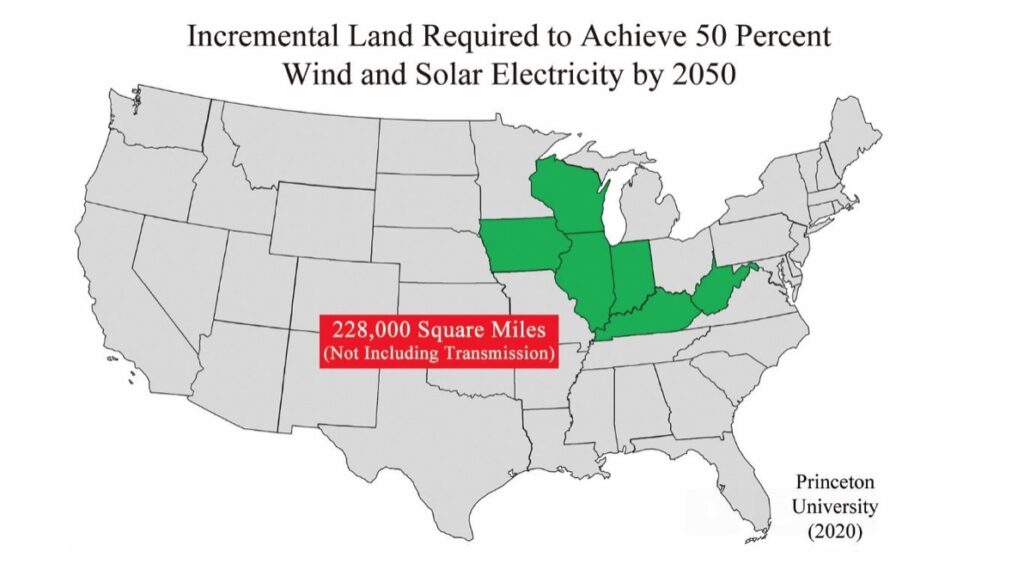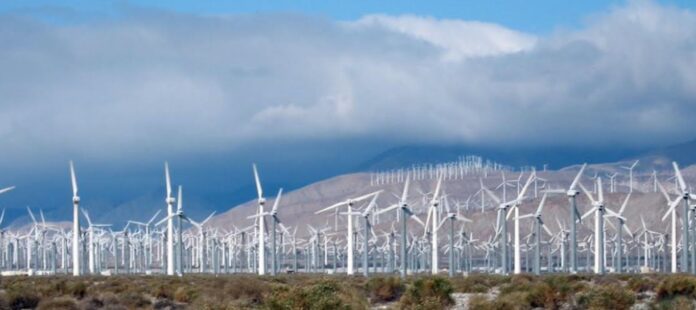By STEVE GOREHAM | THE WESTERN JOURNAL
Which is more environmentally friendly, an energy source that uses one unit of land to produce one unit of electricity, or a source that uses 100 units of land to produce one unit of electricity?
The answer should be obvious. Nevertheless, green energy advocates call for a huge expansion of wind, solar, and other renewables that use vast amounts of land to replace traditional power plants that use comparatively small amounts of land.
Vaclav Smil, professor emeritus of the University of Manitoba in Canada, extensively analyzed the power density of alternative sources used to generate electricity. He defined the power density of an electrical power source as the average flow of electricity generated per square meter of horizontal surface (land or sea area). The area measurement to estimate power density is complex. Smil included plant area, storage yards, mining sites, agricultural fields, pipelines and transportation, and other associated land and sea areas in his analysis.
Smil’s work allows us to compare the energy density of electricity sources. If we set the output of a nuclear plant to one unit of land required for one unit of electricity output, then a natural gas-powered plant requires about 0.8 units of land to produce the same one unit of output. A coal-fired plant uses about 1.4 units of land to deliver an average output of one unit of power.
But renewable sources require vastly more land. A stand-alone solar facility requires about 100 units of land to deliver the same average electricity output of a nuclear plant that uses one unit of land. A wind facility uses about 35 units of land if only the concrete wind tower pads and the service roads are counted, but over 800 units of land for the entire area spanned by a typical wind installation. Production of electricity from biomass suffers the poorest energy density, requiring over 1,500 units of land to output one unit of electricity.
As a practical example, compare the Ivanpah Solar Electric Generating System in the eastern California desert to the Diablo Canyon Nuclear Plant near Avila Beach, California. The Ivanpah facility produces an average of about 793 gigawatt-hours per year and covers an area of 3,500 acres. The Diablo Canyon facility generates about 16,165 gigawatt-hours per year on a surface area of 750 acres. The nuclear plant delivers more than 20 times the average output on about one-fifth of the land, or 100 times the power density of the solar facility.
To approach 100 percent renewable electricity using primarily wind and solar systems, the land requirements are gigantic. “Net-Zero America,” a 2020 study published by Princeton University, calls for wind and solar to supply 50 percent of US electricity by 2050, up from about 14 percent today. The study estimated that this expansion would require about 228,000 square miles of new land (590,000 square kilometers), not including the additional area needed for transmission lines. This is an area larger than the combined area of Illinois, Indiana, Iowa, Kentucky, West Virginia, and Wisconsin.
This area would be more than 100 times as large as the physical footprint of the coal and natural gas power systems that would be replaced.

The land taken for wind and solar can seriously impact the environment. Stand-alone solar systems blanket fields and deserts, blocking sunlight and radically changing the ecosystem, and driving out plants and animals.
Since 2000, almost 16 million trees have been cut down in Scotland to make way for wind turbines, a total of more than 1,700 trees felled per day. This environmental devastation will increase the longer Net Zero goals are pursued.
Wind and solar are dilute energy. They require vast amounts of land to generate the electricity required by modern society. Without fears about human-caused global warming, wind and solar systems would be considered environmentally damaging.
Net-zero plans for 2050, powered by wind and solar, will encounter obstacles with transmission, zoning, local opposition, and just plain space that are probably impossible to overcome.
Steve Goreham is a speaker on energy, the environment, and public policy and the author of the new book “Green Breakdown: The Coming Renewable Energy Failure.” This column first appeared in The Western Journal.

Suzanne ma’am is that a real picture it’s a forest of them wind tunnels???? they are a sore thumb on fire island who on earth would do that stuck on stupid stuff??? Rigged Elections. Is the photo a real place????
Oath: Looks like a California picture to me. It’s real, they’re just as ugly in person too. Down in the lower 48 they call them wind farms, and they look like that. Down in Texas at night, the red and white lights from the tops of each turbine in the wind farms down there flash all night long.
Don’t forget to mention that Eminent Domain will be utilized soon to seize land from private owners. The rationale being it can quickly be converted to green energy projects for the greater good.
They won’t/can’t eminent domain on the chicoms, who are buying up huge tracts of American farmland.
There’s a push to install solar panels on the roofs of buildings in the West which obviously would not encumber raw land.
There area many top-down coercive “pushes” surrounding climate hysteria and the fantasy of “green energy”, none of which make any sense from an economic or environmental perspective. But radical statists like you never let trivialities like facts, numbers and big-picture perspectives from getting in the way of your pet mandates and pie-in-the-sky projects.
Roofs are only so big, whereas vacant raw land could hold many many more panels……..you see? That’s why they want the empty land…..and not the top of a building that they would have to provide recompense to the owner of…..okay? I know it’s hard but, try to open your mind a bit. Also…..we can’t put the big wind turbines on top our houses….so that’s gonna be a “no” as well. Yeah….
And its not empty land. Most of the time, PV arrays are installed in deserts which, though they may appear empty, are actually thriving ecosystems.
My parents in southern California were”pushed” into installing a solar water heater on their roof some 40 years ago. It didn’t last long. In addition to not providing any noticeable natural gas savings, it soon leaked into the attic, and the repairs (combined with the initial cost of the unit) was a very noticeable net loss.
In Alaska on the grid the return on investment does not really pencil out. A solar panel has a ‘life expectancy’ of about 20 years but it would take 20-25 years to recoup investment. In remote off grid locations it makes more sense and also villages but many are without sun during the most needful months. Then no matter where you are you need sun. Period. This has not been a good year for sun. Cutting down all the trees to maximize solar is counter productive as trees absorb the ‘dreaded ?’ CO2. Wind turbines need steady wind. Not the wind of the Matsu or some coastal areas. The wind turbines are designed to shut down in high gust winds so won’t be producing electricity. Then along with the vast land space needed, there are the production components. Solar panels contain cadmium telluride, copper indium selenide, cadmium gallium di-selenide, hexafluroethane, lead and polyvinyl fluoride. All toxic, all base elements of the compounds mined in third world countries often by children. How in the world is that good for the environment or people?
Then there are the battery banks. I won’t even go there right now.
What is driving this is the climate cult and the fear they purposely perpetuate to move the minions, us, to do their bidding for the purpose of power and control. Certainly exploring alternatives for viable energy is not a bad thing but a sensible person would weigh all the variables and choose the best fit for their situation and not simply buy into an unfounded questionable narrative.
Stupid is, as stupid does. ?
Green energy is NOT good for humanity. So called green energy only pencils for those making the components. It is a get rich scheme, land grab by the elites. Green energy not only doesn’t pencil a return on investment; none of the components can be recycled, they must be put in landfills. So what will happen with the tons and tons and tons of toxic waste from batteries, wind generators and solar panels? Stop the madness! Climate change is a hoax just like COVID!
“green” energy only pencils out (both environmentally and economically) if you ignore the side effects, and total lifecycle impacts/costs.
.
Too many examples to cite, but the advocates for green energy focus strictly on the “emissions” during use, but ignore those for manufacture, installation, operations, and eventual removal. They also ignore the impacts to the land and wildlife. How many CO2 capturing plants are destroyed to put in a wind/solar farm?
Insolation (amount of energy the sun deposits) is a finite amount per square meter. You can’t get past that TANSTAAFL it’s Science!!. Not the Fauci kind!
But but but global warming…
Still no one is talking about nuclear. Small footprint, HUGE power returns. Idiots amongst us.
Clean Nuclear energy the the best, but NO!! everyone can’t.. AND Won’t understand it’s BEST BENEFITS. regardless of the Anti- nuclear IDIOTS..
“Which is more environmentally friendly, an energy source that uses one unit of land to produce one unit of electricity, or a source that uses 100 units of land to produce one unit of electricity?.”…….”
The more environmentally friendly is the one the Gaia religion identifies with, because that is a religious question, not a science question.
Why haven’t any proposals for micro nuclear power plants been proposed by our ever so smart government? The TechKnowledge has been available for years and there are several companies. that are able to provide such environmentally safe reactors on a smaller footprint, than the land hogging windmills and solar rays.